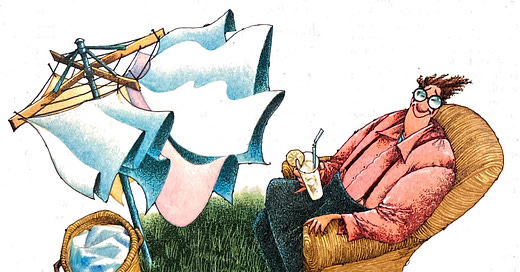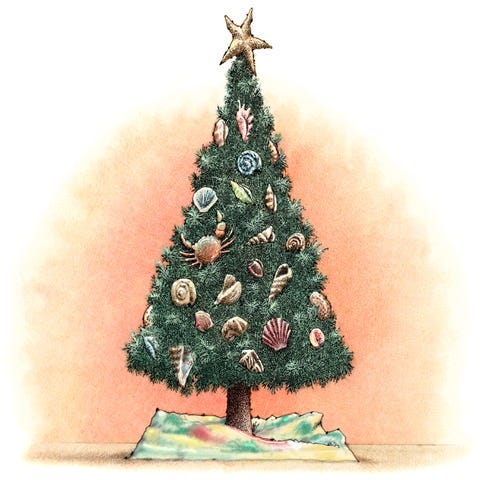By Richard Conniff
One autumn, many years ago now, my family moved out of our beloved old house into a temporary rental near the beach. All our worldly goods were in storage, and we were bereft of our customary New England amusements—turning the compost heap, cutting the hedge, fixing the loose shutter that flapped in the north wind. Then we discovered a substitute in our new backyard, a festive, umbrella-like icon of Ozzie-and-Harriet days. I mean the clothesline.
It seems strange to admit, but, well into middle age, neither my wife, Karen, nor I had ever used one before. For us, the challenge of drying the laundry had consisted entirely in choosing between the knit cycle or permanent press, and overcoming the demon of all dryers, which is, of course, static cling. It dawned on us in about the third week of using the clothesline, a rotary model, that something new and wholly unexpected was taking place.
“Are you trying to beat me to the laundry?” Karen demanded one sunny morning.
“Don’t be absurd,” I lied.
The truth was that both of us had discovered the pleasure of hanging clothes on the line. The simple wooden pegs. The radiant morning sun. The way the shirts seemed to lift and dance together in the wind. Every once in a while, when I'd just hung up a sheet, the wind would take it and spin it gently away from me to belly out like a sail, bringing the next empty section of clothesline directly over my laundry basket. It gave me a sense of harmony with the elements to start the day like this, and also to finish the day between sun-smelling sheets.
Moreover, it had occurred to us in our frugal New England souls that sunlight was cheap, and the electric dryer surely was not. The clothesline required no combustion, caused no carbon dioxide emissions, and was guiltless of both climate change and static cling.
About the only material goods from our old house to escape storage were our best bedsheets, and Karen seemed to take particular pleasure in hanging them out to dry. They were pale yellow, with blue-and-white borders, and they were lovely to see caught up with the wind on one side and the sun on the other. The way she stood back and watched them billow made me think the sheets were a lingering tie to our old home.
We both agreed that this could not go on. Winter was coming, and it was already evident that neither of us was much good at bringing the laundry back in again. We tended to neglect this chore until dusk, or the beginning of a rainstorm. Often, we delegated it to one of our boys. They didn't share our enthusiasm for the clothesline, which made their cotton gym socks stiff, and they suffered from Wretched Hearing in Adolescents (or Wha? Syndrome). So it was sometimes a day or two before the laundry came back in. But December rolled around, and even on frosty mornings Karen and I were still vying to be the first one out the door with a basket of new laundry.
One day early in the month, the whole family was out for a walk on the beach, and we started to make plans for the coming Christmas season—where to put up the tree in the new house, what kind of side dishes to make for dinner. Suddenly, it dawned on Karen that our Christmas lights, the tree skirt, the Mele Kalikimaka CD, and all our ornaments were in storage. A gloom descended upon us, and we walked on down the beach in silence. Without our old house, it would not seem like Christmas at home. Without our familiar tarnished ornaments, it would hardly feel like Christmas at all. Jamie, our eldest son, picked up the delicate spiral shell of a whelk and turned it over idly in his hand. "Why don't we make ornaments out of seashells?" he said.
“Like Mr. Whiskers in Cranberry Christmas!" our 8-year-old daughter, Clare, exclaimed, recalling a favorite book about a New England Christmas. So we began to gather up crab carapaces, whelks, mussels, clamshells, and slipper shells. We took them back to the house to bleach overnight in diluted chlorine. Then we fashioned hangers for each shell out of old fishing line. I happened to be on the phone one night with my sister, and I told her what we were up to.
“Oh, what a memorable Christmas this will be," she said. Being humbuggish by nature, I listened for ironic undertones: "You mean you're going to decorate your Christmas tree with dead shellfish?" or "Don't you think that's just a little Martha Stewart?" But my sister is good-natured and meant it in the best possible joy-to-the world way.
A few nights later, the children began decorating. They took the shells out to the backyard and hooked them one at a time over the end of a stick. Then one child held up the stick under the porch floodlight while another sprayed the shell with green or gold or red paint. The air was crisp, and the paint made beautiful drifting cloudlets of color under the light. The shells coming back into the house one by one were also beautiful, especially the whelk egg-case chains, which spiraled down from the branches like the ocean equivalent of icicles. At the kitchen table, the children sprinkled the clam shells and crab carapaces with gold glitter, and by the end of the evening, we had a beautiful Christmas tree.
The next morning, Jamie and I were up early to inspect our handiwork. He happened to glance out the kitchen window, and I heard him gasp. The night before, my wife had asked him to bring in the clothes from the line, and he had forgotten. There in the brightening dawn, an entire load of laundry still hung, beyond range of the porch floodlight, just downwind from the Christmas ornament decorating area. And there hung one of my wife's favorite bedsheets, a last vestige of our old life, covered now in a wild overspray of red, green and gold paint.
"I don't know you," I muttered to my son.
"Dad!" he replied.
"OK, OK, let's think about this."
My younger son, Ben, the problem-solver and peer-mediator, came up with the intrepid solution. In the half-light of morning, we crept out to the clothesline and took down everything but the sheet, which had shielded most of the laundry from damage. (We could live with green underpants.) Then we proceeded to empty all three cans of spray paint on the prized sheet. Jamie stepped back after a while to consider the artistic effect.
"It's kind of gaudy," he said, and he moved in again to obliterate one last bit of the original yellow-and-blue motif with the red spray paint.
"It's garish," Ben agreed, dismally. The sun was growing brighter and time was running short.
"Let's just call it festive," I concluded.
So we took the sheet inside and bundled it around the base of the Christmas tree. The paint was still wet in the globby, thick folds, so we sprinkled on glitter for the final artistic touch. The living room smelled like an auto body shop.
We delegated Clare to show her mom our new Christmas tree skirt. Clare didn't entirely understand what was going on, which was a good thing. Maybe it wasn't in the best possible spirit of the season, but my sons and I figured that cowering behind an innocent child was a reasonable survival strategy. Also, cuteness was a factor. Clare hurried to get her mother out of bed and proudly brought her in to see the new Christmas tree skirt.
"Oh, my God," her mom gasped, and tears sprang to her eyes. "My sheet!" she cried.
Clare's eyes widened with horror, suddenly recognizing our awful betrayal.
"Mama!" she sobbed. Seeing that look, Karen knelt down and embraced her daughter, pausing just long enough to glower daggers of wrath at the boys and me. But her voice betrayed nothing.
"Oh, Clare," she said, "it's just beautiful. It's the most beautiful tree skirt I've ever seen."
After we started to breathe again, the boys and I smiled down beatifically on this touching mother-daughter scene. Then, quietly as possible, we faded away and retreated to the far corners of the neighborhood.
So the tree skirt stayed, and as my sister said, it was a memorable Christmas, possibly the most beautiful one we'd ever had--somewhere between festive and gaudy, as good Christmases so often seem to be. The shells glittered among the tree lights, and beneath them, that painted sheet took on a lovely, luminous quality.
When spring came that year, we moved out of our rental house and into the new house we had been building, just around the corner. We retrieved all our earthly goods from the storage company and settled in among our old chairs and pictures.
In time, our children have grown older. They have children of their own now. The gaudy tree skirt has vanished somewhere along the way, sadly. But each year at Christmas we still bring out what’s left of the spray-painted whelks and the slipper shells, and we put on the Mele Kalikimaka album (on Spotify now), to remind us of that first Christmas we spent at the beach.
Karen and I still hang the laundry on the current clothesline, and even now, it doesn’t always get brought back in on time, especially not around Christmas.
P.S. I’ll be off for Christmas, and I look forward to seeing you again in the New Year. Whatever you celebrate, at home or abroad, with family, with newfound friends, or alone if you choose, I wish you the very best of holidays.
Richard Conniff’s books include The Species Seekers: Heroes, Fools and the Mad Pursuit of Life on Earth (W.W. Norton), Spineless Wonders: Strange Tales of the Invertebrate World (Henry Holt), and House of Lost Worlds: Dinosaurs, Dynasties, and the Story of Life on Earth (Yale). He is a former contributing opinion writer for The New York Times, and a National Magazine Award-winning feature writer for Smithsonian, National Geographic, The Atlantic, and other publications.







Drying laundry on the line uses the latest technology—all wind and solar!
For Dick and Karen and Family: a very Merry and Peaceful Christmas and good health in the upcoming year. This is too brief to distill the grattitude I have for your friendship, so I'll just use the words of Hilaire Belloc, "May all my enemies go to hell. Noel, noel, noel!"